Intel Core i7 4960X (Ivy Bridge E) Review
by Anand Lal Shimpi on September 3, 2013 4:10 AM EST- Posted in
- CPUs
- Intel
- Ivy Bridge
- Ivy Bridge-E
Gaming Performance
Chances are that any gamer looking at an IVB-E system is also considering a pretty ridiculous GPU setup. NVIDIA sent along a pair of GeForce GTX Titan GPUs, totalling over 14 billion GPU transistors, to pair with the 4960X to help evaluate its gaming performance. I ran the pair through a bunch of games, all at 1080p and at relatively high settings. In some cases you'll see very obvious GPU limitations, while in other situations we'll see some separation between the CPUs.
I haven't yet integrated this data into Bench, so you'll see a different selection of CPUs here than we've used elsewhere. All of the primary candidates are well represented here. There's Ivy Bridge E and Sandy Bridge E of course, in addition to mainstread IVB/SNB. I threw in Gulftown and Nehalem based parts, as well as AMD's latest Vishera SKUs and an old 6-core Phentom II X6.
Bioshock Infinite
Bioshock Infinite is Irrational Games’ latest entry in the Bioshock franchise. Though it’s based on Unreal Engine 3 – making it our obligatory UE3 game – Irrational had added a number of effects that make the game rather GPU-intensive on its highest settings. As an added bonus it includes a built-in benchmark composed of several scenes, a rarity for UE3 engine games, so we can easily get a good representation of what Bioshock’s performance is like.
We're running the benchmark mode at its highest quality defaults (Ultra DX11) with DDOF enabled.
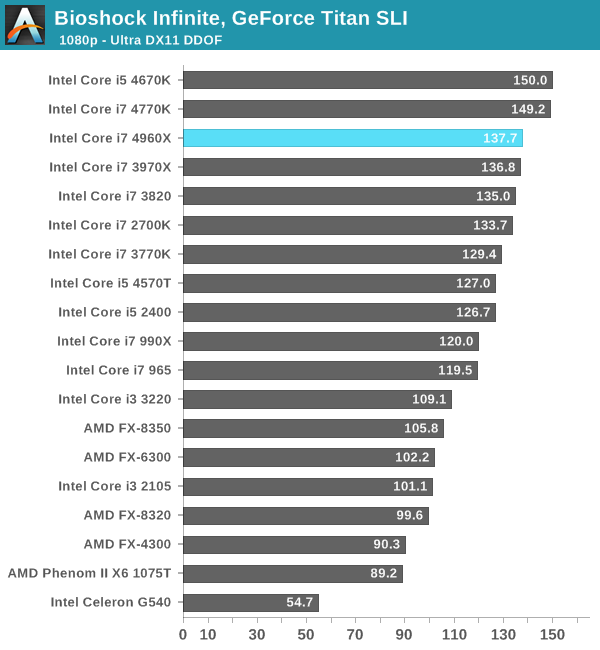
We're going to see a lot of this I suspect. Whenever we see CPU dependency in games, it tends to manifest as being very dependent on single threaded performance. Here Haswell's architectural advantages are appearent as the two quad-core Haswell parts pull ahead of the 4960X by about 8%. The 4960X does reasonably well but you don't really want to spend $1000 on a CPU just for it to come in 3rd I suppose. With two GPUs, the PCIe lane advantage isn't good for much.
Metro: Last Light
Metro: Last Light is the latest entry in the Metro series of post-apocalyptic shooters by developer 4A Games. Like its processor, Last Light is a game that sets a high bar for visual quality, and at its highest settings an equally high bar for system requirements thanks to its advanced lighting system. We run Metro: LL at its highest quality settings, tesselation set to very high and with 16X AF/SSAA enabled.
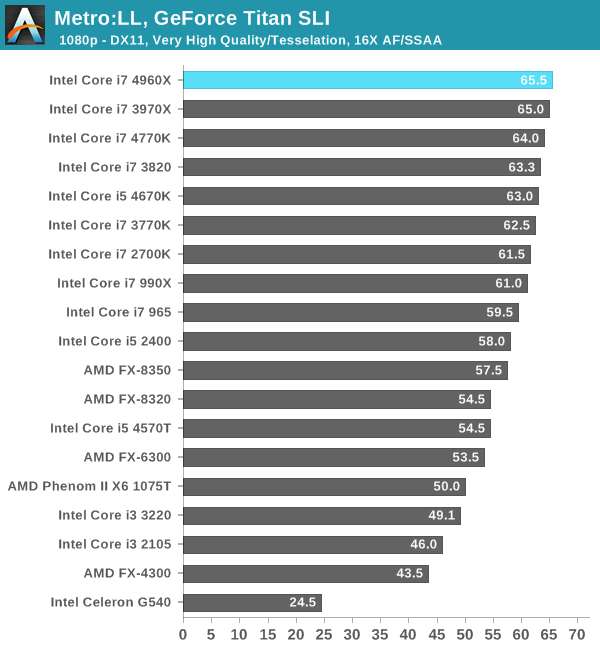
The tune shifts a bit with Metro: LL. Here the 4960X actually pulls ahead by a very small amount. In fact, both of the LGA-2011 6-core parts manage very small leads over Haswell here. The differences are small enough to basically be within the margin of error for this benchmark though.
Sleeping Dogs
A Square Enix game, Sleeping Dogs is one of the few open world games to be released with any kind of benchmark, giving us a unique opportunity to benchmark an open world game. Like most console ports, Sleeping Dogs’ base assets are not extremely demanding, but it makes up for it with its interesting anti-aliasing implementation, a mix of FXAA and SSAA that at its highest settings does an impeccable job of removing jaggies. However by effectively rendering the game world multiple times over, it can also require a very powerful video card to drive these high AA modes.
Our test here is run at the game's Extreme Quality defaults.
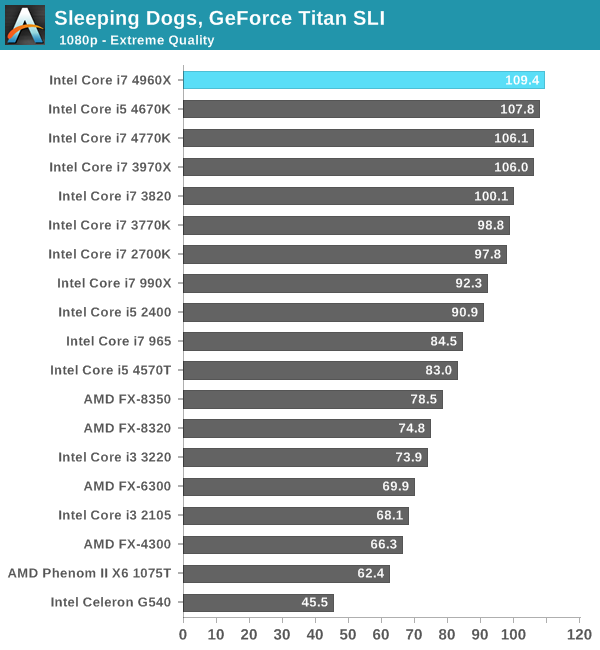
Sleeping Dogs shows similar behavior of the 4960X making its way to the very top, with Haswell hot on its heels.
Tomb Raider (2013)
The simply titled Tomb Raider is the latest entry in the Tomb Raider franchise, making a clean break from past titles in plot, gameplay, and technology. Tomb Raider games have traditionally been technical marvels and the 2013 iteration is no different. Like all of the other titles here, we ran Tomb Raider at its highest quality (Ultimate) settings. Motion Blur and Screen Effects options were both checked.
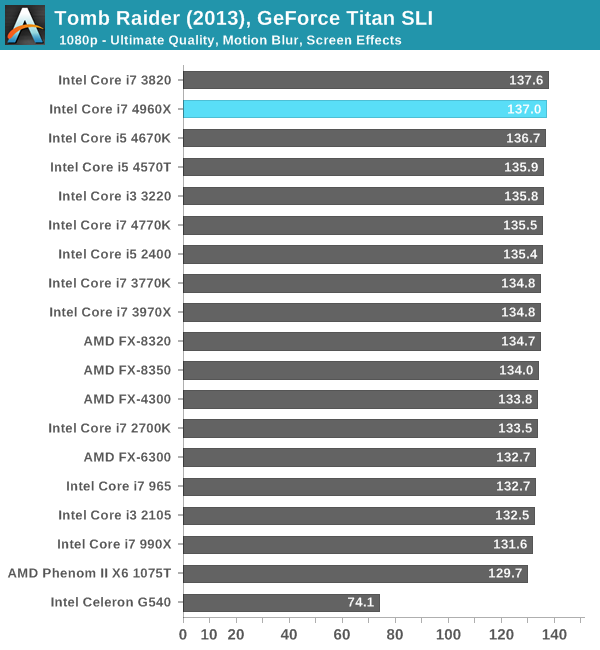
With the exception of the Celeron G540, nearly all of the parts here perform the same. The G540 doesn't do well in any of our tests, I confirmed SLI was operational in all cases but its performance was just abysmal regardless.
Total War: Shogun 2
Our next benchmark is Shogun 2, which is a continuing favorite to our benchmark suite. Total War: Shogun 2 is the latest installment of the long-running Total War series of turn based strategy games, and alongside Civilization V is notable for just how many units it can put on a screen at once. Even 2 years after its release it’s still a very punishing game at its highest settings due to the amount of shading and memory those units require.
We ran Shogun 2 in its DX11 High Quality benchmark mode.
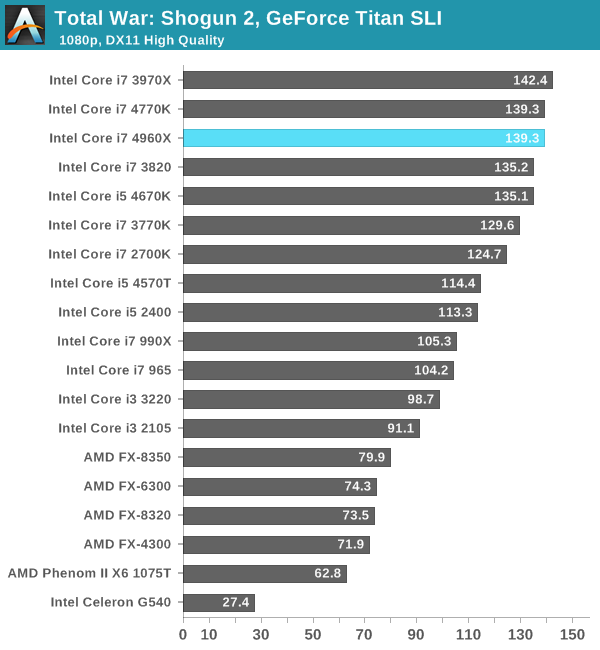
We see roughly equal performance between IVB-E and Haswell here.
GRID 2
GRID 2 is a new addition to our suite and our new racing game of choice, being the very latest racing game out of genre specialty developer Codemasters. Intel did a lot of publicized work with the developer on this title creating a high performance implementation of Order Independent Transparency for Haswell, so I expect it to be well optimized for Intel architectures.
We ran GRID 2 at Ultra quality defaults.
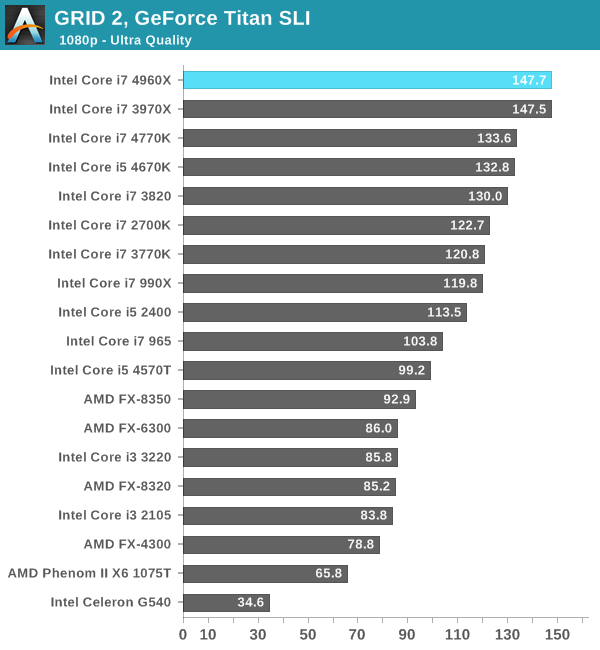
We started with a scenario where Haswell beat out IVB-E, and we're ending with the exact opposite. Here the 10% advantage is likely due to the much larger L3 cache present on both IVB-E and SNB-E. Overall you'll get great gaming performance out of the 4960X, but even with two Titans at its disposal you won't see substantially better frame rates than a 4770K in most cases.










120 Comments
View All Comments
knirfie - Tuesday, September 3, 2013 - link
Why not use a gaming benchmark that does benefit from the extra cores, such as Civ5?ShieTar - Tuesday, September 3, 2013 - link
Or Starcraft 2?JarredWalton - Tuesday, September 3, 2013 - link
Hahahaha.... best 1.5 core benchmark around!althaz - Tuesday, September 3, 2013 - link
It sure does murder one core though.BrightCandle - Tuesday, September 3, 2013 - link
or Arma 3.There are games out there that can utilise more cores and yet you didn't test with any of them.
bds71 - Tuesday, September 3, 2013 - link
as someone who regularly does encoding, 4k gaming, and (when not in use otherwise) folding@home - all things which can fully leverage mult-core processors and powerfull GPUs - i look forward to these reviews of new enthusiast class processors. and, it saddens me that since SB-E there have been only marginal improvements in this sector. i never thought we (as a technology power-house, and as a society) would settle for this. for me, it all began when they started putting GPUs on-die with CPUs for desktop PCs (sure, for laptops i can certainly understand) - i mean who DOESN'T use a discreet GPU in a desktop system???? and for those who do, why don't you just get a laptop???GPUs on-die took the focus away from the CPU. and, while there are minimal gains to be had, the showing here today is abysmal. 2 yrs of waiting and we get a 5% increase (for what i do, i want power and could really care less about power draw - as i would say most enthusiasts do). i get it - to build more powerful hardware, it HAS to become more efficient, but it's an evolutionary development process. haswell could very easily be an enthusiast class product: get rid of the rediculous GPU (for the desktop), double the core count, and raise the TDP to 125/130 (haswell-E?) - and they could do it a LOT earlier than 1-2 years from now. come on Intel - stop screwing the guys who you built your reputation on (after all, it's always the fastest/most powerfull hardware that's shown in reviews to boost the reputation of any company).
/rant off/ sorry, this is just very dissapointing.
f0d - Tuesday, September 3, 2013 - link
i agree very disappointingtoo much integration and not enough performance is the problem with modern intel cpus
i dont want integrated graphics and vrm's and whatever else they plan on integrating - i want huge core counts in a single die for the enthusiast platform.!
jabber - Tuesday, September 3, 2013 - link
I think what folks forget is -Just how many of these chips does Intel actually sell a year?
I bet it's tiny. I bet the i3/i5 chips outsell them 50 to 1. Thats why stuff isn't happening at the top so much. The demand has dwindled. Ten years ago a lot of people could eat all the cpu power they could get their hands on. Now? Not so much. Plenty people now still happy with their 2008/9 spec quads. Basically these top end Intel i7 chips are the Mercedes S class. A way for Intel to put new stuff and techniques in, that may or may not filter down in the future generations.
Intel knows the figures and it knows that the action is at the other end of the spectrum. Not for folks that largely want to rip video and run benchmarks all day.
f0d - Tuesday, September 3, 2013 - link
i agree they dont sell as many as the lower end cpu's but why not just sell us an unlocked xeon than can also OC?its not like they would lose money from letting us OC the xeon because the people that would normally buy a xeon for servers etc would never think about overclocking them
then its a win/win situation for intel as they are still getting their xeon money and they will have a decent enthusiast cpu also
and yes i would happily pay 1k (the price i can find current SBE 8 core cpu's) for an OCable 8 core
jabber - Tuesday, September 3, 2013 - link
Indeed and in being happy to pay $1000 for a CPU that puts you in a very very small group.Times are tough. Sell low and sell many.